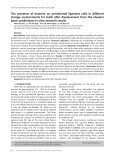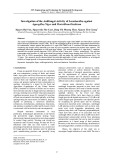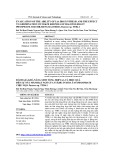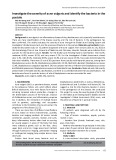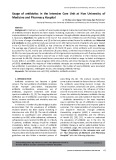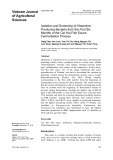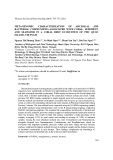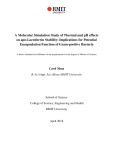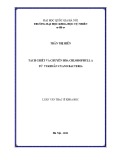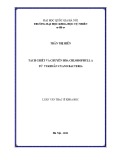Staphylococcal enterotoxin C1-induced pyrogenic cytokine production in human peripheral blood mononuclear cells is mediated by NADPH oxidase and nuclear factor-kappa B Chun-Li Su1, Chun-Chun Cheng2, Mao-Tsun Lin3, Hsiao-Chun Yeh2, Meng-Chou Lee2, Jenq-Chang Lee4 and Shen-Jeu Won2
1 Department of Nursing, Chang Jung Christian University, Tainan, Taiwan 2 Department of Microbiology and Immunology, Medical College, National Cheng Kung University, Tainan, Taiwan 3 Department of Medical Research, Chi-Mei Medical Center, Tainan, Taiwan 4 Department of Surgery, Medical College, National Cheng Kung University, Tainan, Taiwan
Keywords human peripheral blood mononuclear cells; NADPH oxidase; NF-jB; pyrogenic cytokine; staphylococcal enterotoxin C1
Correspondence S.-J. Won, Department of Microbiology and Immunology, Medical College, National Cheng Kung University, no. 1, Ta-Hsueh Road, Tainan 701, Taiwan Fax: +886 6 2082705 Tel: +886 6 2744435 E-mail: a725@mail.ncku.edu.tw
the NADPH oxidase p47phox subunit
(Received 2 April 2007, revised 17 May 2007, accepted 22 May 2007)
doi:10.1111/j.1742-4658.2007.05896.x
The staphylococcal enterotoxins produced by Staphylococcus aureus are associated with pyrogenic response in humans and primates. This study investigates the role of NADPH oxidase and nuclear factor-kappa B (NF-jB) on enterotoxin staphylococcal enterotoxin C1 (SEC1)-induced pyrogenic cytokine production in human peripheral blood mononuclear cells (PBMC). The results indicate that the febrile response to the superna- tant fluids of SEC1-stimulated PBMC in rabbits was in parallel with the levels of interleukin-1b and interleukin-6 in the supernatants. The release of interleukin-1b and interleukin-6, nuclear translocation of NF-jB and its DNA binding activity in the SEC1-stimulated PBMC were time-dependent and were completely eliminated by pyrrolidine dithiocarbamate or SN-50 (NF-jB inhibitors). The release of reactive oxygen species in the super- to natants and translocation of the plasma membrane of SEC1-stimulated PBMC were time-dependent. Administration of apocynin (NADPH oxidase inhibitor) attenuated the febrile response to the supernatants in rabbits and decreased the transloca- tion of NADPH oxidase p47phox subunit and NF-jB activity in the SEC1- stimulated PBMC, and suppressed reactive oxygen species and pyrogenic cytokine production in the supernatants. Taken together, SEC1 may act through an NADPH oxidase mechanism to release reactive oxygen species, which activate NF-jB in PBMC to stimulate the synthesis of pyrogenic cytokines that trigger a fever response in rabbits.
Staphylococcus aureus is a major food-borne pathogen which produces a number of toxins and virulence fac- tors [1]. The staphylococcal enterotoxins produced by
S. aureus are known to cause staphylococcal food poisoning, fever, and toxic shock syndrome, and also cytokine act
immunosuppressors
affect
and
as
Abbreviations Apo, apocynin; EMSA, electrophoretic mobility shift assay; ETYA, 5,8,11,14-eicosatetraynoic acid; FLAP, 5-LOX-activating protein; HBSS, Hanks’ balanced salt solution; HIMO, 1L-6-hydroxymethyl-chiro-inositol-2(R)-2-O-methyl-3-O-octadecylcarbonate; IL, interleukin; 5-LOX, 5-lipoxygenase; MK 886, 3-[1-(p-chlorobenzyl)-5-(isopropyl)-3-t-butylthioindol-2-yl]-2,2-dimethylpropanoic acid; NF-jB, nuclear factor-kappa B; PBMC, human peripheral blood mononuclear cells; PDTC, pyrrolidine dithiocarbamate; PI3K, phosphatidylinositol-3-kinase; ROS, reactive oxygen species; SEs, staphylococcal enterotoxins; SEC1, staphylococcal enterotoxin C1; SP, supernatant fluids of SEC1-stimulated PBMC; TSST-1, toxic shock syndrome toxin-1; Wort, wortmannin.
FEBS Journal 274 (2007) 3633–3645 ª 2007 The Authors Journal compilation ª 2007 FEBS
3633
C.-L. Su et al.
SEC1 induces pyrogenicity via NADPH oxidase
phosphatidyinositol-4,5-bisphosphate
Another activation pathway for NF-jB is via 5-lip- oxygenase (5-LOX), a 78 kDa protein, which is expressed mainly in leukocytes and mast cells [28]. Stimuli trigger the migration of 5-LOX from the cyto- plasm to the plasma membrane, where it associates with 5-LOX-activating protein (FLAP) and metaboli- zes arachidonic acid to release ROS [28,29]. The phos- phatidylinositol-3-kinase (PI3K) ⁄ Akt pathway also affects NF-jB activation [30]. Activated PI3K phos- phorylates to form PIP3, which further activates Akt and affects NF-jB activity [31].
In the present study, SEC1-induced translocation of the NADPH oxidase p47phox subunit, production of superoxide anion, and activation of NF-jB were deter- mined to investigate possible mechanism involved in the release of pyrogenic cytokines from peripheral blood mononuclear cells (PBMC) and the pyrogenic response in rabbits.
Results
production in humans and primates [2,3]. Staphylococ- cal enterotoxins are relatively heat stable [2], and ingestion of staphylococcal enterotoxins causes emesis and diarrhea [4]. Staphylococcus aureus is also an important microorganism of bovine, ovine and caprine mastitis [5]. Staphylococcal enterotoxins, especially sta- phylococcal enterotoxin C, in S. aureus have been iso- lated from the dairy products of infected animals, which could cause problems in public health and food safety [6,7]. The staphylococcal enterotoxins are 26– 30 kDa proteins, and are classified into different toxin serotypes (SEA, SEB, SEC, SED, SEE, SEG, SEH, SEI, and SEJ, etc.) [8]. More than three SEC subtypes (SEC1, SEC2, and SEC3) may exist [1]. SEA to SEE has been reported to account for approximately 95% of staphylococcal food poisoning outbreaks [8]. Pro- duction of SEC1 by S. aureus from patients with toxic shock syndrome has been revealed [9]. SEC1 is a mem- ber of the pyrogenic toxins family that enhances the susceptibility of host to lethal endotoxin shock [2]. SEC1 has also been suggested to be involved in some cases of sudden infant death syndrome [10].
Nuclear factor-kappa B (NF-jB)
Febrile response to the supernatant fluids of the SEC1-stimulated PBMC
temperature began to rise
region of
to the SP was
is a ubiquitous transcription factor which regulates the expression of genes encoding growth factors, chemokines, cyto- kines, cell adhesion molecules and some acute phase proteins both in health and in many diseases [11,12]. NF-jB has been identified in various cell types and is regulated by many inducers, such as ultraviolet irradiation, cytokines, and bacterial or viral products [13–16]. NF-jB in its inactive state resides in the cytoplasm bound to an inhibitory protein known as IjB. Activation of NF-jB is triggered by extracellu- lar stimuli. The IjB is then phosphorylated and pro- teolytically processed by proteasomes and other proteases [17]. This proteolytic process allows trans- location of NF-jB from the cytosol to the nucleus, target to the promoter where it binds genes [18].
including superoxide radicals and H2O2,
To determine whether the supernatant fluids of SEC1- stimulated PBMC (SP) can induce the pyrogenic response, the supernatant fluids obtained from PBMC treated with SEC1 were given intravenously to rabbits. After administration of the SP (1 mLÆkg)1), colonic in a SEC1 concentration-dependent manner (Fig. 1A). This feb- rile response was not affected by polymyxin B (Fig. 1B) but was abolished after heating the SP at 70 (cid:2)C for 30 min (Fig. 1C). Additionally, intravenous less than 30 ngÆkg)1 of SEC1 did not injection of induce a febrile response in rabbits (data not shown). Within the range of 105)108 cellsÆmL)1, the pyrogenic response cell number dependent (Fig. 1D). Over the incubation time of 48–96 h, the pyrogenic responses to the SP were incubation time- related (Fig. 1E). Table 1 indicates that the levels of interleukin (IL)-1b and IL-6 in the SP began to rise at 6 h, and reached their peak levels between 48 and the dose range of 0.2–5.0 ngÆmL)1 of 96 h. Over SEC1, IL-1b and IL-6 in the SP displayed a SEC1 shown). Figure 1F (data not dose-related manner shows that monoclonal antibody to IL-1b or IL-6 had a significant antipyretic effect. The pyrogenic response to the SP was almost completely abrogated combination of anti-IL-1b and anti-IL-6 by the monoclonal IgG but was not affected by the control IgG (Fig. 1F).
Reactive oxygen species (ROS) have been reported to play a pivotal role in many forms of cell signaling as well as activation of NF-jB [19,20]. ROS, including H2O2, superoxide and hydroxyl radicals, are vital for the pathology of inflammatory processes, onset of hypertension and cancer [21–23]. The primary source is of ROS, through the activation of NADPH oxidase in polymor- phonuclear neutrophils [24]. The core enzyme of NADPH oxidase consists of five subunits, p40phox, p47phox, p46phox, p22phox and gp91phox. Upon stimula- the cytosolic p47phox is phosphorylated and tion, moves to the membrane, where it binds to cyto- chrome b558 and becomes an active oxidase [25–27].
FEBS Journal 274 (2007) 3633–3645 ª 2007 The Authors Journal compilation ª 2007 FEBS
3634
C.-L. Su et al.
SEC1 induces pyrogenicity via NADPH oxidase
IgG (100 lgÆmL)1), SEC1 plus anti-IL-1b monoclonal
IgG (100 lgÆmL)1), SEC1 plus anti-IL-6 monoclonal
Fig. 1. The pyrogenic response in rabbits induced by the supernatant fluids of SEC1-treated human PBMC. (A, B) Changes in the colonic temperature (Dtco) of rabbits intravenously injected (1 mLÆkg)1) with the supernatant fluids obtained from PBMC (1 · 107 cellsÆmL)1) treated for 72 h with the vehicle, SEC1 or SEC1 plus polymyxin B (50 lgÆmL)1). (C) Dtco of rabbits injected with the nonheated supernatant fluids obtained from PBMC treated with the vehicle, or SEC1, or with the heated (70 (cid:2)C for 30 min) supernatant fluids obtained from PBMC trea- ted with SEC1 (1 ngÆmL)1). (D) Dtco of rabbits injected with the supernatant fluids obtained from the indicated concentrations of PBMC with 1 ngÆmL)1 of SEC1. (E) Dtco of rabbits injected with the supernatant fluids obtained from PBMC with the vehicle for 72 h or with 1 ngÆmL)1 of SEC1 for the indicated time periods. (F) Dtco of rabbits treated with the supernatant fluids obtained from PBMC with the vehicle, SEC1 (1 ngÆmL)1) plus control IgG (100 lgÆmL)1), or SEC1 plus anti-IL-6 and anti-IL-1b monoclonal IgG. Before injection to rabbits, the indicated antibodies were added to the SEC1-treated supernatants and incubated at 37 (cid:2)C for 30 min. All experimental groups: n ¼ 5, except for those received vehicle (n ¼ 8) or antibody (n ¼ 4). Normal saline was used as the vehicle. * Significantly different from the corresponding values of the vehicle group except for those received heated supernatant (compared with the nonheated SEC1 group) or antibody (compared with the SEC1-treated PBMC plus IgG group).
SEC1 induces NF-jB activation in PBMC
PBMC were treated in the presence or absence of NF- jB inhibitor pyrrolidine dithiocarbamate (PDTC) or SN-50 prior addition of SEC1. After 24 h of incuba-
tion, the supernatant fluids were collected for cytokine analysis and for the fever index of pyrogen test in rab- bits. As shown in Table 2, pretreatment of PBMC with PDTC or SN-50 not only attenuated the SEC1- induced production of IL-1b and IL-6 in the SP, but
FEBS Journal 274 (2007) 3633–3645 ª 2007 The Authors Journal compilation ª 2007 FEBS
3635
C.-L. Su et al.
SEC1 induces pyrogenicity via NADPH oxidase
Table 1. Time course release of the pyrogenic cytokines from SEC1-treated PBMC. The concentrations of pyrogenic cytokines in the supernatant fluids obtained from human PBMC (1 · 107 cellsÆ mL)1) treated with vehicle (normal saline) or SEC1 (1 ngÆmL)1) for the indicated time periods were determined according to the manu- facturer’s instructions. Colorimetric results were read on a multi- scan photometer (MRXII, Dynatech, MeLean, VA, USA) 96-well plate reader at a wavelength of 450 nm. Cytokine levels were quantified by comparison with standards. The sensitivity of IL-1b and IL-6 was < 0.1 and < 0.7 pgÆmL)1, respectively. Data are expressed as the mean ± SEM of triplicate cultures.* Significantly different from the corresponding values of the vehicle group.
Cytokine production (pgÆmL)1)
Table 2. Effects of NF-jB, PI3K ⁄ Akt, 5-LOX ⁄ FLAP and NADPH oxidase inhibitors on SEC1 induced pyrogenic cytokine production and fever index in rabbits. Human PBMC (1 · 107 cellsÆmL)1) were pretreated with or without PDTC (1000 lM), SN-50 (10 lM), Wort (400 nM), HIMO (25 lM), ETYA (60 lM), MK 886 (10 lM) or apocy- nin (Apo, 12.5 lM) for 1 h prior to addition of SEC1 (1 ngÆmL)1). After 24 h of incubation, the supernatant fluids were collected for cytokine analysis and for the fever index of pyrogen test in rabbits. For experiments, 0.01% dimethylsulfoxide (this concentration was tested and revealed to be nontoxic to the cells) was used as the vehicle. Data are expressed as the mean ± SEM of triplicate cul- ture. * Significantly different from the corresponding control values (the vehicle group). (cid:2) Significantly different from the corresponding control values (the SEC1 group). (cid:3) Number of rabbits tested.
IL-6
Time (h)
Treatment
IL-1b
Cytokine production (pgÆmL)1)
6
IL-6
Treatment
IL-1b
Fever index ((cid:2)C)
12
24
160 ± 7 32500 ± 510* 100 ± 3
48
72
96
Vehicle SEC1 Vehicle SEC1 Vehicle SEC1 Vehicle SEC1 Vehicle SEC1 Vehicle SEC1
12 ± 3 691 ± 52* 7 ± 1 1725 ± 71* 13 ± 2 2179 ± 49* 6 ± 1 3011 ± 95* 5 ± 1 3187 ± 75* 9 ± 5 3091 ± 60*
90 ± 9 5000 ± 100* 100 ± 12 26200 ± 200* 102 ± 5 33600 ± 210* 82 ± 8 48300 ± 320* 110 ± 12 70000 ± 440* 108 ± 10 64200 ± 360*
5500 ± 210(cid:2) 271 ± 100 6800 ± 260(cid:2) 330 ± 90 37200 ± 960 200 ± 26 39500 ± 870 403 ± 93 34400 ± 860 283 ± 100 38700 ± 870
Vehicle SEC1 PDTC SEC1 + PDTC SN-50 SEC1 + SN-50 Wort SEC1 + Wort HIMO SEC1 + HIMO ETYA SEC1 + ETYA MK 886 SEC1 + MK 886 Apo SEC1 + Apo
12 ± 3 2141 ± 5* 13 ± 5 176 ± 62(cid:2) 12 ± 7 92 ± 7(cid:2) 27 ± 2 1900 ± 179 22 ± 1 1931 ± 155 16 ± 1 1981 ± 252 25 ± 2 2057 ± 223 2 ± 1 32 ± 2(cid:2)
1 ± 1 3 ± 2(cid:2)
0.18 ± 0.02 (5)(cid:3) 1.06 ± 0.03 (5)* 0.21 ± 0.02 (5) 0.32 ± 0.04 (5)(cid:2) 0.11 ± 0.06 (5) 0.31 ± 0.05 (5)(cid:2) 0.22 ± 0.04 (5) 1.19 ± 0.04 (5) 0.13 ± 0.05 (5) 1.12 ± 0.04 (5) 0.11 ± 0.06 (5) 1.07 ± 0.05 (5) 0.22 ± 0.02 (5) 1.08 ± 0.03 (5) 0.21 ± 0.03 (5) 0.25 ± 0.03 (5)(cid:2)
also inhibited the SEC1-induced febrile response in rabbits. The detection of NF-jB protein in the nucleus became apparent after 30 min and increased dramatic- ally up to 24 h (Fig. 2A). The DNA-binding activity of NF-jB was detected at 30 min of SEC1 treatment and the level kept increasing to 24 h (Fig. 2B). The specificity of the NF-jB band was completely elimin- ated in the presence of a 100-fold excess of the unlabe- led jB oligonucleotide (Fig. 2B, lane 9). Conversely, a 100-fold excess of oligonucleotide probes of the un- labeled mutant jB (Fig. 2B, lane 10) or the unlabeled AP-1 (Fig. 2B, lane 11), a transcription factor contain- ing DNA binding site, had no effect on the ability of
the NF-jB to bind to DNA. The NF-jB subunits were characterized by using a specific antibody for the p50 or p65 subunit, and the results indicate that the NF-jB band intensity reduced in the presence of anti-p50 or anti-p65 IgG (Fig. 2B, lanes 12 and 13). Treatment of PBMC with the NF-jB inhibitors, PDTC or SN-50, inhibited the SEC1-induced NF-jB
Fig. 2. NF-jB activation by SEC1. (A) PBMC (1 · 107 cellsÆmL)1) were treated with the vehicle control (Ctl, normal saline) or SEC1 for west- ern blot analysis using an anti-NF-jB p65 monoclonal IgG. b-actin was similarly assessed to serve as a loading control. The intensity of the individual protein signal was normalized to that of b-actin, with Ctl levels arbitrarily set to 1. (B) PBMC were treated with the vehicle (normal saline) or SEC1 for EMSA. Except for the free probe control, nuclear proteins (10 lg) were used. Specificity was determined by competition of the nuclear protein obtained from the cells treated with 1 ngÆmL)1 of SEC1 for 24 h. The NF-jB-DNA binding activity (lanes 2–8) was quantified by densitometry. The time-course groups were compared with the Ctl group to obtain the relative binding activity. (C) Western blot analysis shows the inhibition of SEC1-induced NF-jB nuclear translocation activity by apocynin (Apo), PDTC or SN-50 in PBMC. PBMC were pretreated with the vehicle (0.5% ethanol; this concentration was tested and revealed to be nontoxic to the cells) or the indicated inhibitors for 1 h before treatment of SEC1 for 24 h. (D) Analysis of EMSA shows the inhibition of SEC1-induced NF-jB activity by the indica- ted inhibitors in PBMC. (E, F) PBMC were treated with the vehicle (normal saline) or SEC1. After incubation, whole cell lysates were pre- pared for western blot analysis using an antiphospho-IjB-a (p-IjB-a), anti-IjB-a (IjB-a), antiphospho-IKK-b (p-IKK-b) or anti-IKK-b (IKK-b) polyclonal IgG.
FEBS Journal 274 (2007) 3633–3645 ª 2007 The Authors Journal compilation ª 2007 FEBS
3636
C.-L. Su et al.
SEC1 induces pyrogenicity via NADPH oxidase
FEBS Journal 274 (2007) 3633–3645 ª 2007 The Authors Journal compilation ª 2007 FEBS
3637
C.-L. Su et al.
SEC1 induces pyrogenicity via NADPH oxidase
IjB-a was
nuclear translocation (Fig. 2C, lanes 5–7). The DNA- binding activity of NF-jB induced by SEC1 was com- pletely blocked by 1000 lm of PDTC (Fig. 2D, lane 7) or 10 lm of SN-50 (Fig. 2D, lane 8). PDTC or SN-50 alone did not affect the nuclear translocation or DNA- binding activity of NF-jB (data not shown). More- over, significantly phosphorylated and degraded at 30 and 60 min, respectively, after treat- ment of PBMC with SEC1 (Fig. 2E). Phosphorylation of IKK-b in the whole cell lysates of SEC1-stimulated PBMC was rapidly increased within 10 min and sus- tained for 60 min, whereas the total IKK-b protein expression was not affected (Fig. 2F).
NF-jB activation is mediated by NADPH oxidase
Fig. 3. Effects of 5-LOX ⁄ FLAP and PI3K ⁄ Akt inhibitors on SEC1- (A) PBMC were treated with the vehicle treated NF-jB activity. (0.01% dimethylsulfoxide; this concentration was tested and revealed not to be toxic to the cells), ETYA (60 lM), MK 886 (10 lM), Wort (400 nM), or HIMO (25 lM) for 1 h before treatment of SEC1 (1 ngÆmL)1) for 24 h. Nuclear proteins were subjected to western blot analysis by using an anti-NF-jB p65 monoclonal IgG. (B) PBMC were pretreated with the vehicle control (Ctl, 0.01% di- methylsulfoxide), ETYA, MK 886, Wort, or HIMO for 1 h before treatment of SEC1 for 24 h. Nuclear proteins were subjected to EMSA.
subunit of NADPH oxidase p47phox appeared (four- fold) on the cell membrane at 2 min, reached its peak level (5.8-fold) at 4 min and stayed (3- or 4.4-fold, respectively) at 12 or 24 min following treatment with SEC1. Conversely, the level of p47phox in the cytoplasm of the SEC1-treated PBMC decreased 80% within 2 min and sustained this level for 24 min (Fig. 5A). Fig- ure 5B demonstrates that the treatment of SEC1-stimu- lated PBMC with apocynin not only profoundly decreased the level of p47phox in the membrane, but also increased the level of p47phox in the cytoplasm. The use the translocation of apocynin alone did not affect of p47phox, production of ROS, nuclear expression of NF-jB or its DNA-binding activity (data not shown).
PBMC were pretreated with or without PI3K ⁄ Akt inhibitor, 1L-6-hydroxymethyl-chiro-inositol- specific 2(R)-2-O-methyl-3-O-octadecylcarbonate (HIMO) or wortmannin (Wort) prior to the addition of SEC1. After 24 h of incubation, the supernatant fluids were collected for the cytokine analysis and for the fever index of pyrogen test in rabbits. As shown in Table 2, neither Wort nor HIMO affected the production of IL-1b or IL-6 in the SP. The induction of the febrile response in rabbits was not affected in the presence of wortmannin or HIMO. Additionally, these inhibitors did not alter the SEC1-induced expression of nuclear NF-jB protein (Fig. 3A, lanes 5 and 6) and its DNA- lanes 6 and 7). Similar binding activity (Fig. 3B, findings were obtained by using 5-LOX inhibitor, 5,8,11,14-eicosatetraynoic acid (ETYA) or FLAP inhib- (3-[1-(p-chlorobenzyl)-5-(isopropyl)-3-t-butylthio- itor acid; MK 886) indol-2-yl]-2,2-dimethylpropanoic (Table 2, Fig. 3A, lanes 3 and 4, and Fig. 3B, lanes 4 and 5). Wort, HIMO, ETYA, or MK 886 alone has no effect on the nuclear translocation or DNA-binding activity of NF-jB (data not shown). Strikingly, treat- ment of PBMC with NADPH oxidase inhibitor (apocy- nin) prior to the addition of SEC1 completely blocked the release of these two cytokines in the SP and attenu- ated the febrile response in rabbits (Table 2). Apocynin also inhibited the SEC1-induced nuclear NF-jB expres- sion (Fig. 2C, lanes 3 and 4) and its DNA-binding activity (Fig. 2D, lanes 4 and 5). Phosphorylation of IKK-b and IjB-a was slightly reduced at 2.5 lm of apocynin and eradicated at 12.5 lm (Fig. 4). The ROS level in the SP increased at 2 min and reached its peak level at 12 min (Table 3) after treatment with SEC1. In the presence of apocynin, but not ETYA or MK 886, inhibited (Table 4). the production of ROS was PI3K ⁄ Akt inhibitors also did not change the formation of ROS (data not shown). Figure 5A indicates that the
FEBS Journal 274 (2007) 3633–3645 ª 2007 The Authors Journal compilation ª 2007 FEBS
3638
C.-L. Su et al.
SEC1 induces pyrogenicity via NADPH oxidase
Table 4. Effects of NADPH oxidase and 5-LOX ⁄ FLAP inhibitors on ROS production in SEC1-treated human PBMC. Human PBMC (5 · 105 cellsÆmL)1) were pretreated with or without apocynin (Apo, 12.5 lM), ETYA (60 lM) or MK 886 (400 nM) for 1 h prior to addition of SEC1 (1 ngÆmL)1). After 12 min of incubation, the supernatant fluids were collected and the contents of ROS were determined. For experiments, 0.01% dimethylsulfoxide was used as the vehicle. Data are expressed as the mean ± SEM of triplicate culture. * Sig- nificantly different from the corresponding values of the SEC1 group.
Treatment
Lucigenin chemiluminescence counts
Vehicle SEC1 SEC1 + Apo SEC1 + ETYA SEC1 + MK 886
93070 ± 2801 689144 ± 18201 74963 ± 542* 728354 ± 61621 758756 ± 15237
Fig. 4. Effects of NADPH oxidase inhibitor on the phosphorylation of IKK-b and IjB-a. PBMC were pretreated with the vehicle control (Ctl, 0.5% ethanol) or apocynin for 1 h before addition of SEC1 (1 ngÆmL)1) for 60 min. Whole cell lysates were prepared for west- ern blot analysis using an antiphospho-IKK-b (p-IKK-b) or antiphos- pho-IjB-a (p-IjB-a) polyclonal IgG.
Table 3. Time-dependent effects of SEC1 on ROS production in human PBMC. Human PBMC (5 · 105 cellsÆmL)1) were treated with the vehicle (normal saline) or SEC1 (1 ngÆmL)1) for the indica- ted time periods. After incubation, the supernatant fluids were col- lected and the contents of ROS were determined. Data are expressed as the mean ± SEM of triplicate culture. * Significantly different from the corresponding values of the 0 min group.
Time (min)
Lucigenin chemiluminescence counts
68016 ± 1187 223689 ± 18061* 312135 ± 27918* 457014 ± 52511* 464427 ± 44959* 496952 ± 36740* 584833 ± 30245*
0 2 4 6 8 10 12
Discussion
study demonstrates
that
the
Fig. 5. Membrane translocation of p47phox in SEC1-treated cells. (A) PBMC were treated with the vehicle control (Ctl, normal saline) or SEC1. (B) PBMC were treated with or without apocynin for 1 h prior to addition of SEC1 for 12 min. After incubation, the mem- brane and cytosol proteins were obtained for western blot analysis using an anti-p47phox polyclonal IgG.
The present febrile response to the supernatant fluids obtained from SEC1-treated human PBMC in rabbits is associated with the levels of IL-1b, IL-6 and ROS in the superna- tant fluids of SEC1-treated human PBMC. Adding
FEBS Journal 274 (2007) 3633–3645 ª 2007 The Authors Journal compilation ª 2007 FEBS
3639
C.-L. Su et al.
SEC1 induces pyrogenicity via NADPH oxidase
PDTC, SN-50 or apocynin to the SEC1-stimulated PBMC attenuates the febrile response and the levels of IL-1b, IL-6 and ROS in the supernatant fluids. Adding an anti-IL-1b or anti-IL-6 monoclonal IgG to the supernatant fluids significantly decreases the febrile response in rabbits. These data indicate that SEC1 may act through NF-jB and NADPH oxidase mecha- nisms in the PBMC to stimulate the synthesis or release of IL-1b, IL-6 and ROS.
FLAP because these phenomena are attenuated by apocynin and not by ETYA, MK 886, Wort or HIMO (Table 2). In addition, SEC1 induces the formation of ROS, and the phosphorylation of IKK-b and IjB-a at 2, 10 and 30 min of stimulation, respectively (Table 3 and Fig. 2E,F). An inhibitor for NADPH oxidase attenuates the movement of p47phox (Fig. 5B), translo- cation of NF-jB (Fig. 2C), DNA-binding activity of NF-jB (Fig. 2D) and phosphorylation of IKK-b, IjB- a (Fig. 4), whereas inhibitors of NF-jB do not affect the ROS generation (data not shown). These phenom- ena imply that NADPH oxidase resides on the upstream of IKK-b, IjB-a and NF-jB. Therefore, SEC1 may act through the following mechanism to induce pyrogenic cytokine production in PBMC: SEC1 triggers the translocation of p47phox from cytoplasm to plasma membrane to activate NADPH oxidase for ROS production which then causes the phosphoryla- tion of IKK-b and IjB-a, and thus activation of NF-jB.
in the promoters of
that
indicate
analysis. These findings
nontreated
in
from 66 pgÆmL)1
Consensus DNA-binding motifs for NF-jB proteins immunologically relevant exist genes, such as the genes for IL-1b and IL-6 [45–47]. Cytokine-induced NF-jB complexes containing p50 and p65 subunits have also been demonstrated in many cell types [48,49]. In the present study, SEC1 induces the translocation of NF-jB which may bind to its target genes to trigger the production of IL-1b and IL-6 that is blocked by the NF-jB inhibitor (PDTC or SN-50). Moreover, the NF-jB binding ability is abro- gated by binding site competition and antibody super- shift the stimulatory effect of SEC1 appears to require NF-jB. For the febrile response, two classes of cytokines have been reported: endogenous pyrogenic cytokines (IL-1 and IL-6) and endogenous antipyretic cytokines (IL-10 and tumor necrosis factor-a) [50]. In the present study, SEC1 stimulate the release of pyrogenic cytokines to trigger febrile responses in rabbits. Cytokines stimula- ted by NF-jB can also directly activate the NF-jB mechanisms and establish a positive autoregulatory loop to amplify the inflammatory reaction [51]. Recently, the production of IL-6 by dendritic cells has been reported [52]. Our parallel study also observed the formation of a large amount of IL-6 when dendrit- ic cells were sorting from the PBMC and stimulated with SEC1 (C.-L. Su & S.-J. Won, unpublished results). The level of IL-6 in the supernatant fluids was to increased 79372 pgÆmL)1 in those treated with 1 ngÆmL)1 of SEC1 for 48 h (C.-L. Su & S.-J. Won, unpublished results). These results suggest that dendritic cells may contribute in part to pyrogenic cytokine production of
ROS have recently gained attention as secondary messengers that regulate intracellular signaling cas- cades and transcription factors. Some investigations have reported that NF-jB can be activated by ROS [32,33] produced by a pathway involving 5-LOX ⁄ FLAP [34], NADPH oxidase [35] or PI3K ⁄ Akt [30]. During NF-jB activation, phosphorylation of IKK- a ⁄ IKK-b heterodimer results in the phosphorylation and degradation of IjB-a, which then leads to the phosphorylation of NF-jB p65 subunit and renders the release of NF-jB p50 ⁄ p65 heterodimer to translo- cate from cytosol to the nucleus where it binds and activates various target genes [36]. During NADPH oxidase activation, phosphorylation of p47phox allows the migration of entire cytosolic complex (p40phox, p47phox and p67phox) to the membrane to associate with cytochrome b558 (containing p22phox and p91phox) to assemble the active oxidase which catalyzes reduction of oxygen to superoxide and leads to the formation of ROS [25]. ROS-induced activation of NF-jB in T cells has been suggested to proceed in part via SHIP-1- mediated phosphorylation of IKK complex or via Syk- dependent phosphorylation of IjB-a [36]. In stimulated phagocytic cells, ROS produced by NADPH oxidase also activates IKK and NF-jB and induces production of proinflammatory cytokine IL-1b via a Toll-like receptor-mediated pathway [37]. Recently, the primary actions of superantigen staphylococcal enterotoxins have been studied. In T cells, SEB or SEC interacts with specific variable b (Vb) elements on a ⁄ b T cell receptor, such as Vb 3, 12, 13.2, 14, 15, 17 and 20 [38,39]. Stimulation of a T cell receptor results in ROS production within short period of time (approximately 10 min), which is dependent on the expression of p47phox [40]. In dendritic cells, on the other hand, SEB reacts with Toll-like receptor 2 or 4 [38,41]. Activation of Toll-like receptor increases p47phox expression and time point elevates ROS formation at a later (> 30 min) [42]. Phosphorylation of p47phox has also been suggested to via protein kinase C or via interleu- kin-1 receptor-associated kinase 4 in a cell-free system [43,44]. In the present study, the cytokine synthesis and febrile response induced by SEC1 is dependent on NADPH oxidase and not on PI3K ⁄ Akt or 5-LOX ⁄
FEBS Journal 274 (2007) 3633–3645 ª 2007 The Authors Journal compilation ª 2007 FEBS
3640
C.-L. Su et al.
SEC1 induces pyrogenicity via NADPH oxidase
incubation, the supernatants of PBMC were harvested by centrifugation at 800 g and stored at )80 (cid:2)C before use.
Pyrogen assay
PBMC. However, long-term exposure (approximately 10 days) of SEC1 to bovine PMBC has been reported to induce tolerance by increasing IL-10 and trans- forming growth factor-b, and decreasing IL-2 [53,54]. The major cell type for the IL-10 formation and Th2 shift has been characterized to be T regulatory (CD8+CD26+ or CD4+CD25+ in bovines; cells CD4+CD25+ in humans) [53–55].
As described previously [59], adult male New Zealand White rabbits from the Animal Center of National Cheng Kung University (NCKU, Tainan, Taiwan) with body weight between 2.2 and 3.0 kg were housed individually at an ambi- ent temperature of 22 ± 1 (cid:2)C under a 12 : 12 h light ⁄ dark cycle (lights on 06.00 h). The pyrogen assay was carried out using unanaesthetized animals which were restrained in rab- bit stocks. Animal feed and water were provided ad libitum. The colonic temperature [60] of each animal was measured every minute with a copper constantan thermocouple con- nected to a thermometer (HR1300, Yokogawa, Tokyo, Japan) during the experimental period between 09.00 and 20.00 h. Only animals with stable body temperatures in the range 38.6–39.0 (cid:2)C were used to determine the effect of the tested agents. All animal experiments were approved by the Animal Research Committee of National Cheng Kung University, and were conducted under the guidelines of the National Research Council, Taiwan.
Reagents
in vitro and febrile
cytokines
study contained £ 25 pgÆmL)1
NADPH oxidase contains a redox center which cat- alyzes superoxide formation by transferring electrons from NADPH onto oxygen molecules [56]. A defici- ency of one PHOX subunit in NADPH oxidase leads to the inhibition of superoxide generation, and results in chronic granulomatous disease [57]. ROS derivatives of superoxide also mediate signaling transduction [22]. In nonphagocytic cells, such as fibroblasts, endothelial cells, vascular smooth muscle cells, cardiac myocytes and thyroid tissue, ROS are produced in one third of neutrophils in response to hormones or local metabolic changes [22]. ROS also amplify the immune response by enhancing the receptor signaling cascades of T cells [58]. In experimental systems, ROS increase IL-2 for- mation in antigenically or mitogenically stimulated T cells. In the present study, SEC1 induces transloca- tion of p47phox from the cytoplasm to the cell mem- brane (Fig. 5A), ROS production (Table 3), pyrogenic cytokine formation (Table 1), and the febrile response (Fig. 1A and Table 2). The inhibitor of NADPH oxid- ase (apocynin) decreases ROS formation (Table 4), responses pyrogenic in vivo (Table 2). Taken together, the present study demonstrates that the bacterial enterotoxin SEC1 may activate NADPH oxidase in PBMC to produce ROS which may act though NF-jB to trigger the produc- tion of pyrogenic cytokine IL-1b and IL-6.
Experimental procedures
PBMC preparation
All drug solutions were prepared in pyrogen-free glassware that was heated for 5 h before use. All solutions were passed through 0.22 lm filters (Millipore, Bedford, MA, USA). Sterile SEC1 (Toxin Technology, Sarasota, FL, USA) was made up in normal saline solution. The SEC1 endotoxin used in this because none of the SEC1 solutions induced gelation in the Limulus amebocyte lysate (Gibco BRL) assay. Chemicals were obtained from Sigma Chemical Co. unless otherwise indicated. SN-50, HIMO and MK 886 were purchased from Calbiochem (San Diego, CA, USA). Polymycin B was obtained from Merck (Darmstadt, Germany). Apocynin was purchased from Fluka (Riedel-de Haen, Germany). SN-50 and PDTC were dissolved in distilled water. Wort, HIMO, MK 886 and ETYA were dissolved in dimethylsulf- oxide. Apocynin was dissolved in ethanol. Polymycin B was dissolved in normal saline. Before use, all dissolved chemi- cals were diluted with AIM-V medium to yield the final desired experimental concentrations.
FEBS Journal 274 (2007) 3633–3645 ª 2007 The Authors Journal compilation ª 2007 FEBS
3641
Primary antibodies including mouse monoclonal NF-jB p65, rabbit polyclonal NF-jB p65, goat and rabbit poly- clonal NF-jB p50, and rabbit polyclonal p47phox were obtained from Santa Cruz Biotechnology (Santa Cruz, CA, USA). Rabbit polyclonal IjB-a, phospho-IjB-a, IKK-b, and phospho-IKK-a ⁄ IKK-b were purchased from Cell Signaling (Beverly, MA, USA). Human monoclonal IL-1b and IL-6 antibodies were obtained from R&D Systems (Minneapolis, MN, USA). Human PBMC freshly collected buffy coat fraction of whole blood from healthy donors at the Tainan Blood Bank Center (Tainan City, Taiwan) were isolated by centrifugation over a Ficoll-Paque (Amersham Pharmacia, Uppsala, Sweden) den- sity gradient at 400 g for 30 min at room temperature in a Sorvall RT6000B (Du Pont, DE, USA) [59]. The cells collec- ted at the interface were washed thrice with serum-free RPMI-1640 (Gibco BRL, Grand Island, NY, USA) and sub- sequently resuspended in an AIM-V medium (Gibco BRL) containing 50 lgÆmL)1 of gentamicin (Sigma Chemical Co., St Louis, MO, USA). For experiments, the indicated concen- tration of PBMC was incubated with the different concentra- the tested agents in a 37 (cid:2)C incubator. After tions of
C.-L. Su et al.
SEC1 induces pyrogenicity via NADPH oxidase
Cytokine secretion assay
the collected supernatants were
IL-6 was IL-1b 1.3 · 108 UÆmg)1 Human PBMC (1 · 107 cellsÆmL)1) were incubated with SEC1 alone or cocultured with the tested inhibitors. After stored at incubation, )80 (cid:2)C and later used for cytokine analysis. The concentra- tions of IL-1b and IL-6 in the SEC1-stimulated PBMC supernatants were determined by human Colorimetric Sandwich ELISA kits (R&D Systems). The specific activity and and of 1 · 106 UÆmL)1, respectively. HC1, pH 8, 4 mm EDTA, pH 8, 2 mm EGTA 0.05 mm phenylmethylsulfonyl fluoride and 20 lgÆmL)1 leupeptin). After sitting on ice for 30 min, the mixture was transferred to a Dounce homogenizer. The cells were broken with ten strokes of a pestle. The homogenate was centrifuged at 650 g for 5 min to remove unbroken cells and nuclei. After centrifugation at 150 000 g for 45 min, the obtained super- natant was used as the cytosolic fraction. The pellet was resuspended in lysis buffer containing 0.5% Triton X-100 and then sat on ice for 50 min. After centrifugation at 150 000 g for another 30 min, the resulting supernatant was used as the membrane fraction.
Preparations of whole cell lysates and nuclear fractions
Immunoblotting
leupeptin, 5 lgÆmL)1
Human PBMC (1 · 107 cellsÆmL)1) were treated with or without the tested agents. The protein extraction was per- formed as previously described [61]. Briefly, the whole cells were lysed with 200 lL lysis buffer containing 1 mm EDTA, 10 mm Tris ⁄ HCl, pH 7.4, 0.5% (w ⁄ v) SDS, 0.15 m NaCl, 1 mm EGTA, 5 lgÆmL)1 aprotinin, 2 mm sodium 0.5 mm phenyl- orthovanadate, methylsulfonyl fluoride, and 1% (v ⁄ v) Triton X-100 at 4 (cid:2)C for 35 min. The mixture was centrifuged at 15 000 g for 10 min, and the resulting supernatant was used as the whole cell lysate for immunoblotting.
The protein contents of the whole cell, cytosolic, plasma membrane and nuclear fractions were determined by a pro- tein assay kit (Bio-Rad, Hercules, CA, USA). All isolated proteins were stored at )80 (cid:2)C before use. The proteins were resolved using 10–12% SDS ⁄ PAGE with a running buffer (25 mm Tris, 192 mm glycine, 3.5 mm SDS, pH 8.3) and subsequently transferred to polyvinylidene fluoride membranes (Millipore) as described previously [64]. The membranes were blocked by incubation in NaCl ⁄ TrisT (20 mm Tris, 137 mm NaCl, 0.05% Tween-20, pH 7.4) con- taining 5% skim milk for 2 h at room temperature. The membrane was then probed with an appropriate first anti- body. A secondary probe with horseradish peroxidase-labe- led goat antimouse (1 : 5000) or goat antirabbit (1 : 5000) IgG was visualized by exposing to X-ray film after staining with chemiluminescence reagents.
Electrophoretic mobility shift assay (EMSA)
Nuclear fractions were prepared as previously described [62]. Agent-treated PBMC (1 · 107 cellsÆmL)1) were isolated by centrifugation and washed twice with ice-cold NaCl ⁄ Pi. The PBMC were then lysed in 400 lL of buffer A (10 mm Hepes, pH 7.9, 3 mm sodium orthovanadate, 5 mm MgC12, 10 mm KC1, 10 mm NaF, 0.5 mm phenylmethylsulfonyl fluoride, 0.5 mm dithiothreitol and 2 lgÆmL)1 each of apro- tinin, leupeptin, antipain, and pepstatin A), and incubated on ice for 20 min. The nuclear fractions were isolated by centrifugation at 11 000 g at 4 (cid:2)C for 10 s. The obtained nuclear pellets were resuspended in 60 lL of buffer B (1.5 mm MgC12, 420 mm NaCl, 20 mm Hepes, pH 7.9, 0.2 mm EDTA, 10 mm NaF, 25% glycerol, 1 mm sodium 0.5 mm phenyl- 0.5 mm dithiothreitol, orthovanadate, methylsulfonyl fluoride and 1 lgÆmL)1 each of antipain, leupeptin, aprotinin, and pepstatin A) and then incubated for 20 min on ice with occasional mixing. The nuclear debris was removed by centrifugation at 12 000 g for 16 min at 4 (cid:2)C. The nuclear protein extracts were used for further assay.
Preparations of cytosolic and membrane fractions
FEBS Journal 274 (2007) 3633–3645 ª 2007 The Authors Journal compilation ª 2007 FEBS
3642
as previously treated with or without purchased The EMSA of the nuclear extracts was performed as des- cribed previously [65]. The probe consisting of a double- stranded oligonucleotide with the consensus binding sequence for NF-jB (5¢-AGTTGAGGGGACTTTCCCAG GC-3¢) (Promega, Madison, WI, USA) was 3¢ end-labeled with digoxigenin-ddUTP using a digoxigenin gel shift kit (Roche Molecular Biochemicals, Mannheim, Germany). The binding reaction was carried out for 30 min at 37 (cid:2)C according to the manufacturer’s protocol for experiments the (Roche, Molecular Biochemicals). The specificity of protein–DNA complexes was proven by immunoreactivity with goat or rabbit polyclonal antibody specific for p65 or p50 (Santa Cruz Biotechnology) of NF-jB. To further dem- onstrate the specificity, a competition assay was conducted by adding a 100-fold excess of the unlabeled oligonucleo- tides or unlabeled mutant NF-jB oligonucleotides (5¢-AG TTGAGGCGACTTTCCCAGGC-3¢; Santa Cruz Biotech- nology) to the nuclear extracts. The NF-jB-unrelated oligo- nucleotide probe control, AP-1 binding site (5¢-CGCT TGATGAGTCAGCCGGAA-3¢), was from Promega. The gels were transferred to Hybond-N plus Plasma membranes were enriched by differential centrifuga- tion [63]. Human PBMC described (1 · 107 cellsÆmL)1) the tested agents were washed with NaCl ⁄ Pi and scraped with a rub- ber policeman into an ice-cold lysis buffer (50 mm Tris-
C.-L. Su et al.
SEC1 induces pyrogenicity via NADPH oxidase
2 Bohach GA, Fast DJ, Nelson RD & Schlievert PM membrane (Amersham Biosciences, Little Chalfont, UK), dried and subjected to autoradiography.
(1990) Staphylococcal and streptococcal pyrogenic tox- ins involved in toxic shock syndrome and related illnes- ses. Crit Rev Microbiol 17, 251–272.
Determination of ROS
3 Kotzin BL, Leung DY, Kappler J & Marrack P (1993)
Superantigens and their potential role in human disease. Adv Immunol 54, 99–166. a
4 Thompson NE, Ketterhagen MJ & Bergdoll MS (1984) Monoclonal antibodies to staphylococcal enterotoxins B and C: cross-reactivity and localization of epitopes on tryptic fragments. Infect Immun 45, 281–285. 5 Cremonesi P, Vimercati C, Pisoni G, Castiglioni B,
Luzzana M, Ruffo G & Moroni P (2006) Identification of enterotoxin genes in Staphylococcus aureus isolates from bovine and caprine milk. Vet Res Commun 30 (Suppl. 1), 241–243.
6 Soejima T, Nagao E, Kubota T, Yamagata H & Kagi H (2004) Comparison between ultrafiltration and tri- chloroacetic acid precipitation method for concentration of Staphylococcus aureus enterotoxin in dairy samples. Int J Food Microbiol 93, 185–194. 7 Kuroishi T, Komine K, Kai K, Itagaki M, Kobayashi ROS, including superoxide radical and H2O2, were deter- mined using lucigenin-enhanced chemiluminescence method as described previously [66,67]. Briefly, human PBMC (5 · 105 cellsÆmL)1) in Hanks’ balanced salt solu- tion (HBSS; pH 7.4, 1.25 mm CaCl2) were treated with or without SEC1, or incubated with or without the tested agents [68]. After the indicated time periods, the sample was prepared by adding 0.2 mL of the cell culture superna- tants to 0.1 mL HBSS in the dark and mixed using the Chemiluminescence Analyzing System (TLU-21, Tohoku Electronic Industrial Co., Sendai, Japan). The photon emis- sion from the sample was measured every 10 s at 37 (cid:2)C. After 200 s, the samples were measured continuously for 12 min after injecting 1 mL of 10 lm lucigenin (Sigma Chemical Co.) in HBSS into the stainless cell of the system. The area under the curve was calculated to obtain total chemiluminescence.
Statistical analysis
J, Ohta M, Kamata S & Kumagai K (2003) Concentra- tions and specific antibodies to staphylococcal entero- toxin-C and toxic shock syndrome toxin-1 in bovine mammary gland secretions, and inflammatory response to the intramammary inoculation of these toxins. J Vet Med Sci 65, 899–906. 8 Omoe K, Ishikawa M, Shimoda Y, Hu DL, Ueda S &
Shinagawa K (2002) Detection of seg, seh, and sei genes in Staphylococcus aureus isolates and determination of the enterotoxin productivities of S. aureus isolates Harboring seg, seh, or sei genes. J Clin Microbiol 40, 857–862.
9 Bohach GA, Kreiswirth BN, Novick RP & Schlievert PM (1989) Analysis of toxic shock syndrome isolates producing staphylococcal enterotoxins B and C1 with use of southern hybridization and immunologic assays. Rev Infect Dis 11 (Suppl. 1), S75–S81. The animals were maintained at an ambient temperature of 22 (cid:2)C for at least 90 min to obtain the thermal balance before any tested agent was injected. The temperature responses were assessed as changes from the preinjection values. The experimental results are presented as mean ± SEM for multiple experiments. The results were compared by one-way analysis of variance using the minitab (version 10.2) software package (Minitab Inc., State College, PA, USA). P < 0.05 was considered statistically significant. The maximum elevation of the colonic temperature over the preinjection value (Dtco) and the fever index, given by the area under the curve over the 1-h period after the injec- tion of the tested agents, were calculated in terms of (cid:2)C per 1 h [69].
Acknowledgements
10 Zorgani A, Essery SD, Madani OA, Bentley AJ, James VS, MacKenzie DA, Keeling JW, Rambaud C, Hilton J, Blackwell CC et al. (1999) Detection of pyrogenic toxins of Staphylococcus aureus in sudden infant death syndrome. FEMS Immunol Med Microbiol 25, 103–108. 11 Baeuerle PA & Baltimore D (1996) NF-kappa B: ten years after. Cell 87, 13–20.
This study was supported by grants from the National Science Council, Taiwan, Republic of China (NSC 89- 2320-B-006-113, NSC 90-2314-B-006-123, NSC 93- 2320-B-309-002 and NSC 95-2313-B-309-001).
References
1 Chen TR, Hsiao MH, Chiou CS & Tsen HY (2001)
FEBS Journal 274 (2007) 3633–3645 ª 2007 The Authors Journal compilation ª 2007 FEBS
3643
12 Courtois G (2005) The NF-kappaB signaling pathway in human genetic diseases. Cell Mol Life Sci 62, 1682–1691. 13 Baeuerle PA & Baltimore D (1988) Activation of DNA- binding activity in an apparently cytoplasmic precursor of the NF-jB transcription factor. Cell 53, 211–217. 14 Leung K & Nable GJ (1988) HTLV-1 transactivator induces interleukin-2 receptor expression through an NF-kappa-B-like factor. Nature 333, 776–778. Development and use of PCR primers for the investiga- tion of C1, C2 and C3 enterotoxin types of Staphylococ- cus aureus strains isolated from food-borne outbreaks. Int J Food Microbiol 71, 63–70.
C.-L. Su et al.
SEC1 induces pyrogenicity via NADPH oxidase
15 Kim JH, Jung JH, Jeon ST, Kim H, Ock J, Suk K, phorylated inositol lipids. Annu Rev Biochem 70, 535– 602. 32 Schreck R, Rieber P & Baeuerle PA (1991) Reactive
Kim SI, Song KS & Lee WH (2006) Decursin inhibits induction of inflammatory mediators by blocking NF-jB activation in macrophages. Mol Pharmacol 69, 1783–1790. oxygen intermediates as apparently widely used messen- gers in the activation of the NF-kappa B transcription factor and HIV-1. EMBO J 10, 2247–2258.
16 Laos S, Baeckstrom D & Hansson GC (2006) Inhibition of NF-kappaB activation and chemokine expression by the leukocyte glycoprotein, CD43, in colon cancer cells. Int J Oncol 28, 695–704. 33 Shi C, Zhao X, Wang X & Andersson R (2005) Role of nuclear factor-kappaB, reactive oxygen species and cel- lular signaling in the early phase of acute pancreatitis. Scand J Gastroenterol 40, 103–108.
34 Bonizzi G, Piette J, Merville MP & Bours V (2000) Cell type-specific role for reactive oxygen species in nuclear factor-kappaB activation by interleukin-1. Biochem Pharmacol 59, 7–11. 17 Imbert V, Rupec RA, Livolsi A, Pahl HL, Traenckner EB, Mueller-Dieckmann C, Farahifar D, Rossi B, Auberger P, Baeuerle PA et al. (1996) Tyrosine phos- phorylation of I kappa B-alpha activates NF-kappa B without proteolytic degradation of I kappa B-alpha. Cell 86, 787–798.
18 Rice NR & Ernst MK (1993) In vivo control of NF- kappa B activation by I kappa B alpha. EMBO J 12, 4685–4695. 35 Fan J, Frey RS, Rahman A & Malik AB (2002) Role of neutrophil NADPH oxidase in the mechanism of tumor necrosis factor-alpha-induced NF-kappa B activation and intercellular adhesion molecule-1 expression in endothelial cells. J Biol Chem 277, 3404–3411.
36 Gloire G, Legrand-Poels S & Piette J (2006) NF-kap- paB activation by reactive oxygen species: fifteen years later. Biochem Pharmacol 72, 1493–1505. 19 Babior BM, Kipnes RS & Curnutte JT (1973) Biological defense mechanisms. The production by leukocytes of superoxide, a potential bactericidal agent. J Clin Invest 52, 741–744. 20 Finkel T (1998) Oxygen radicals and signaling. Curr Opin Cell Biol 10, 248–253. 21 Babior BM (2000) Phagocytes and oxidative stress. Am 37 Asehnoune K, Strassheim D, Mitra S, Kim JY & Abra- ham E (2004) Involvement of reactive oxygen species in Toll-like receptor 4-dependent activation of NF-kappa B. J Immunol 172, 2522–2529. J Med 109, 33–44. 38 Deringer JR, Ely RJ, Stauffacher CV & Bohach GA 22 Droge W (2002) Free radicals in the physiological con- trol of cell function. Physiol Rev 82, 47–95. 23 Kerr S, Brosnan MJ, McIntyre M, Reid JL, Domini- (1996) Subtype-specific interactions of type C staphylo- coccal enterotoxins with the T-cell receptor. Mol Micro- biol 22, 523–534.
czak AF & Hamilton CA (1999) Superoxide anion pro- duction is increased in a model of genetic hypertension: role of the endothelium. Hypertension 33, 1353–1358. 24 DeLeo FR & Quinn MT (1996) Assembly of the phago- 39 Deringer JR, Ely RJ, Monday SR, Stauffacher CV & Bohach GA (1997) Vbeta-dependent stimulation of bovine and human T cells by host-specific staphylococ- cal enterotoxins. Infect Immun 65, 4048–4054. cyte NADPH oxidase: molecular interaction of oxidase proteins. J Leukoc Biol 60, 677–691. 25 Babior BM (1999) NADPH oxidase: an update. Blood 93, 1464–1476. 26 Diebold BA & Bokoch GM (2005) Rho GTPases and 40 Jackson SH, Devadas S, Kwon J, Pinto LA & Williams MS (2004) T cells express a phagocyte-type NADPH oxidase that is activated after T cell receptor stimula- tion. Nat Immunol 5, 818–827. 41 Mandron M, Aries MF, Brehm RD, Tranter HS,
Acharya KR, Charveron M & Davrinche C (2006) Human dendritic cells conditioned with Staphylococcus aureus enterotoxin B promote TH2 cell polarization. J Allergy Clin Immunol 117, 1141–1147. the control of the oxidative burst in polymorphonuclear leukocytes. Curr Top Microbiol Immunol 291, 91–111. 27 Brandes RP & Kreuzer J (2005) Vascular NADPH ox- idases: molecular mechanisms of activation. Cardiovasc Res 65, 16–27. 28 Ford-Hutchinson AW, Gresser M & Young RN (1994)
5-Lipoxygenase. Annu Rev Biochem 63, 383–417. 29 Parker CW (1987) Lipid mediators produced through the lipoxygenase pathway. Annu Rev Immunol 5, 65–84. 30 Kuo MT, Liu Z, Wei Y, Lin-Lee YC, Tatebe S, Mills 42 Vulcano M, Dusi S, Lissandrini D, Badolato R, Mazzi P, Riboldi E, Borroni E, Calleri A, Donini M, Plebani A et al. (2004) Toll receptor-mediated regulation of NADPH oxidase in human dendritic cells. J Immunol 173, 5749–5756. 43 Park JW, Hoyal CR, Benna JE & Babior BM (1997)
FEBS Journal 274 (2007) 3633–3645 ª 2007 The Authors Journal compilation ª 2007 FEBS
3644
GB & Unate H (2002) Induction of human MDR1 gene expression by 2-acetylaminofluorene is mediated by effectors of the phosphoinositide 3-kinase pathway that activate NF-kappaB signaling. Oncogene 21, 1945–1954. Kinase-dependent activation of the leukocyte NADPH oxidase in a cell-free system. Phosphorylation of mem- branes and p47PHOX during oxidase activation. J Biol Chem 272, 11035–11043. 44 Pacquelet S, Johnson JL, Ellis BA, Brzezinska AA, Lane WS, Munafo DB & Catz SD (2007) Cross-talk 31 Vanhaesebroeck B, Leevers SJ, Ahmadi K, Timms J, Katso R, Driscoll PC, Woscholski R, Parker PJ & Waterfield MD (2001) Synthesis and function of 3-phos-
C.-L. Su et al.
SEC1 induces pyrogenicity via NADPH oxidase
between IRAK-4 and the NADPH oxidase. Biochem J 403, 451–461. 45 Clark BD, Collins KL, Gandy MS, Webb AC & Auron
58 Hehner SP, Breitkreutz R, Shubinsky G, Unsoeld H, Schulze-Osthoff K, Schmitz ML & Droge W (2000) Enhancement of T cell receptor signaling by a mild oxi- dative shift in the intracellular thiol pool. J Immunol 165, 4319–4328. 59 Won SJ, Huang WT, Lai YS & Lin MT (2000) Sta-
PE (1986) Genomic sequence for human prointerleukin 1 beta: possible evolution from a reverse transcribed pro- interleukin 1 alpha gene. Nucl Acids Res 14, 7897–7914. 46 Trede NS, Geha RS & Chatila T (1991) Transcriptional activation of IL-1 beta and tumor necrosis factor-alpha genes by MHC class II ligands. J Immunol 146, 2310– 2315. phylococcal enterotoxin A acts through nitric oxide syn- thase mechanisms in human peripheral blood mononuclear cells to stimulate synthesis of pyrogenic cytokines. Infect Immun 68, 2003–2008. 47 Nedospasov SA, Shakhov AN, Turetskaya RL, Mett
60 Snitcowsky R (1996) Rheumatic fever prevention in industrializing countries: problems and approaches. Pediatrics 97, 996–998.
61 Watabe M, Machida K & Osada H (2000) MT-21 is a synthetic apoptosis inducer that directly induces cyto- chrome c release from mitochondria. Cancer Res 60, 5214–5222. VA, Azizov MM, Georgiev GP, Korobko VG, Dobry- nin VN, Filippov SA & Bystrov NS (1986) Tandem arrangement of genes coding for tumor necrosis factor (TNF-alpha) and lymphotoxin (TNF-beta) in the human genome. Cold Spring Harb Symp Quant Biol 51 Part 1, 611–624.
62 Feng SH & Lo SC (1999) Lipid extract of Mycoplasma penetrans proteinase K-digested lipid-associated mem- brane proteins rapidly activates NF-jB and activator protein 1. Infect Immun 67, 2951–2956. 48 Spink J, Cohen J & Evans TJ (1995) The cytokine responsive vascular smooth muscle cell enhancer of inducible nitric oxide synthase. Activation by nuclear factor-kappa B. J Biol Chem 270, 29541–29547. 63 Moran A, Handler JS & Turner RJ (1982) Na+-
49 Jimi E & Ghosh S (2005) Role of nuclear factor-kappaB in the immune system and bone. Immunol Rev 208, 80–87. dependent hexose transport in vesicles from cultured renal epithelial cell line. Am J Physiol 243, C293–C298. 64 Chendil D, Das A, Dey S, Mohiuddin M & Ahmed
50 Leon LR (2002) Invited review: cytokine regulation of fever: studies using gene knockout mice. J Appl Physiol 92, 2648–2655.
MM (2002) Par-4, a pro-apoptotic gene, inhibits radi- ation-induced NF kappa B activity and Bcl-2 expression leading to induction of radiosensitivity in human pros- tate cancer cells PC-3. Cancer Biol Ther 1, 152–160. 65 Gotoh T, Oyadomari S, Mori K & Mori M (2002) 51 Yamamoto Y & Gaynor RB (2001) Therapeutic poten- tial of inhibition of the NF-kappaB pathway in the treatment of inflammation and cancer. J Clin Invest 107, 135–142.
Nitric oxide-induced apoptosis in RAW 264.7 macroph- ages is mediated by endoplasmic reticulum stress path- way involving ATF6 and CHOP. J Biol Chem 277, 12343–12350. 52 Wan S, Xia C & Morel L (2007) IL-6 produced by dendritic cells from lupus-prone mice inhibits CD4+CD25+ T cell regulatory functions. J Immunol 178, 271–279.
66 Li Y, Zhu H, Kuppusamy P, Roubaud V, Zweier JL & Trush MA (1998) Validation of lucigenin (bis-N-methyl- acridinium) as a chemilumigenic probe for detecting superoxide anion radical production by enzymatic and cellular systems. J Biol Chem 273, 2015–2023. 53 Chang BS, Bohach GA, Lee SU, Davis WC, Fox LK, Ferens WA, Seo KS, Koo HC, Kwon NH & Park YH (2005) Immunosuppression by T regulatory cells in cows infected with Staphylococcal superantigen. J Vet Sci 6, 247–250. 67 Costa D, Gomes A, Reis S, Lima JL & Fernandes E 54 Seo KS, Lee SU, Park YH, Davis WC, Fox LK &
(2005) Hydrogen peroxide scavenging activity by non- steroidal anti-inflammatory drugs. Life Sci 76, 2841– 2848.
Bohach GA (2007) Long-term staphylococcal enterotox- in C1 exposure induces soluble factor-mediated immu- nosuppression by bovine CD4+ and CD8+ T cells. Infect Immun 75, 260–269.
55 Pontoux C, Banz A & Papiernik M (2002) Natural CD4 CD25+ regulatory T cells control the burst of superan- tigen-induced cytokine production: the role of IL-10. Int Immunol 14, 233–239. 68 Leo R, Pratico D, Iuliano L, Pulcinelli FM, Ghiselli A, Pignatelli P, Colavita AR, FitzGerald GA & Violi F (1997) Platelet activation by superoxide anion and hydroxyl radicals intrinsically generated by platelets that had undergone anoxia and then reoxygenated. Circula- tion 95, 885–891.
FEBS Journal 274 (2007) 3633–3645 ª 2007 The Authors Journal compilation ª 2007 FEBS
3645
56 Roos D, van Bruggen R & Meischl C (2003) Oxidative killing of microbes by neutrophils. Microbes Infect 5, 1307–1315. 57 Babior BM (2004) NADPH oxidase. Curr Opin Immunol 16, 42–47. 69 Lin MT, Chern YF & Chen SY (1985) Depletion of noradrenalin in the hypothalamus reduces the febrile response induced by prostaglandin E2, thyrotropin-re- leaseing hormone and b-endorphin. Neuropharmacology 24, 1039–1042.



